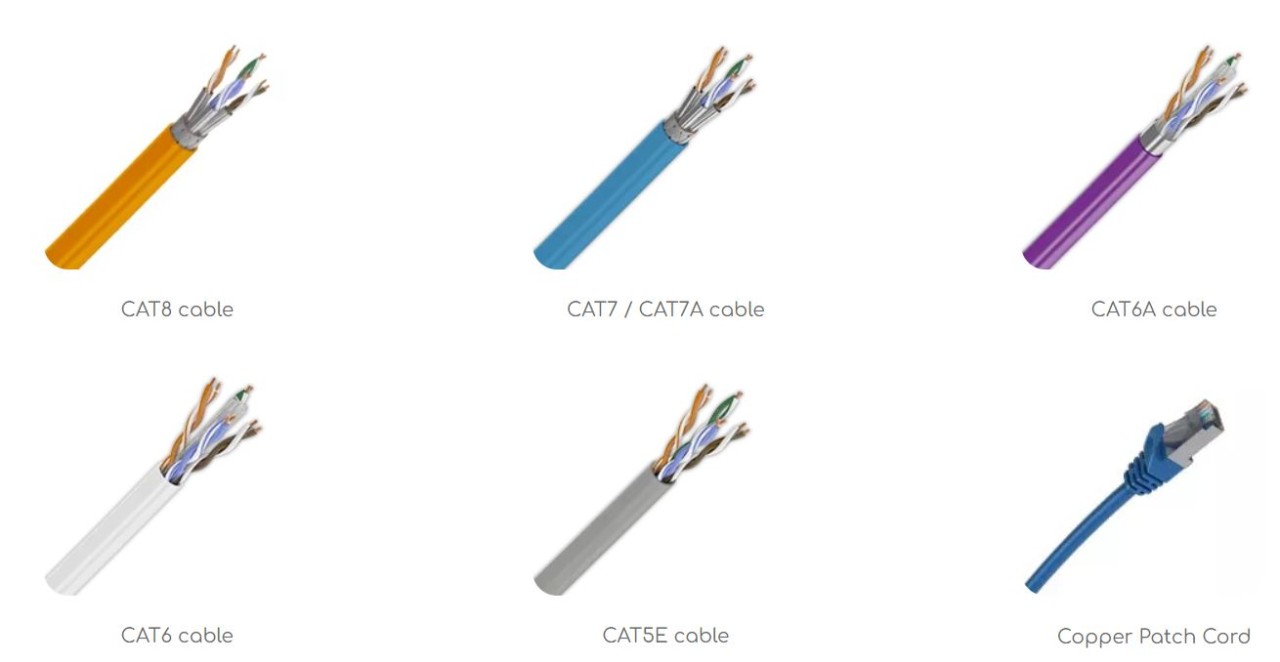
Ethernet Cable/LAN Cable: Types-CAT 5e,6,6a,7,8
What are Ethernet cables?
- Ethernet is a family of wired computer networking technologies commonly used in Local Area Networks (LANs), Metropolitan Area Networks (MANs), and Wide Area Networks (WANs) to allow computer workstations, servers, and printers to share data and resources. Invented by Xerox PARC researcher Bob Metcalfe in 1973.
- Today, Ethernet connects hundreds of millions of devices in homes and businesses.
- In this article, we'll explain the types of Ethernet cables that form the basis of many wired networks, the primary manufacturing process, standards for testing, major packaging types, and how customers choose them.
How are Ethernet cables classified?

- "Cat" in Cat5e, Cat6, Cat7, Cat8, etc., is the abbreviation of "Category". Ethernet cables are primarily categorized by bandwidth (measured in MHz), maximum data rate (measured in Mbit/s), and shielding.
Choosing the right Ethernet cable category for your network
- If you're shopping for Ethernet cables, focus on these four characteristics and you'll make an informed decision. In some cases, other factors are worth considering, so if in doubt, please report back and we can explore together.
- 1 Speed (Data Rate): The speed of a cable refers to the amount of data it can transmit per second. The cable's category designation (such as Cat5e, Cat6, etc.) is an easy way to identify the speed of the cable.
- 2 Shielding: Some Ethernet cables are shielded to protect the cable's conductors from electromagnetic interference (EMI) caused by power lines, large machinery, and fluorescent lights. Shielding also prevents parallel conductors inside the cable jacket from interfering with each other.
- 3 Cable length: The maximum length of an Ethernet cable is approximately 295 feet (90 meters). A good quality cable with a shield and thicker conductors can travel farther, but it will take trial and error. Remember that cables are rarely straight, so plan on extra cables for some twists.
- 4 Installation location: The cable sheath has a fire safety rating. For the main CPR and UL standards, you can choose PVC, LSZH, UL-CM, CMR, CMP, etc., according to the environmental requirements.
Bandwidth vs. Data Rate(Speed)

- Bandwidth or frequency is a property of a cable and measures the rate at which a signal will cycle each second. 1 MHz is equal to 1 million cycles per second. Cat6 can handle up to 250 million signals a second (or 250 MHz). The cable category with the highest bandwidth is currently Cat8 with 2 billion (2 GHz) signals per second, 8 times as many as Cat6.
- Data Rate is defined as the amount of data transmitted during a specified time period over a network. It is the speed at which data is transferred from one device to another or between a peripheral device and the computer. Cat6's bandwidth is 250 Mhz but the data rate is 10 Gbps.
- Bandwidth (Frequency) and data rate (max. support speed) can be increased by increasing the gauge of the conductor wires, adding more twists to the conductors, or adding shielding to each pair of conductors.
Ethernet cable shielding
- Cable shielding is a layer of material that wraps around the wires inside a cable to reduce interference and improve signal quality. Shielding helps prevent external electromagnetic interference (EMI) and radio frequency interference (RFI) from affecting data transmission on the cable.
- Shielded Ethernet cables can have two types of shielding:
- Conductor shielding uses aluminum foil or braided strands to protect each twisted pair
- The cable shield wraps all twisted pairs in aluminum foil or braided strands


Main categories of Ethernet cables

Ethernet patch cords/Copper patch cords
- Ethernet patch cables also called patch cords, are short lengths of Cat5e, Cat6, or Cat6A used to connect PDs to networks. And patch cables are often used for short distances in offices and wiring closets. Ethernet patch cable can link a computer to a network hub, router, or Ethernet switch, which is useful to people constructing home computer networks.
Conductor types:
- Standard: strand conductor twisted together from seven very fine wires
- Certain application: Solid core
- Material:Bare Copper
Modular Plug types: RJ45

Mainly Types:

Producing Reference Standards of twisted pair cables
- UL444/UL1581/UL1666/IEC60332-1/IEC60332-3-24/EN50
Test Standards
- ISO/IEC11801, ANSI/TIA-568-C.2
Main Testing equipment
- 1 Fluke: DSX2-8000,DSX2-5000,DTX-1800
- 2) Network Analyzers
Ethernet cable production flow chart
- Conductor Drawing → Insulation → Twisting → Cable Twisting → Jacket Line
